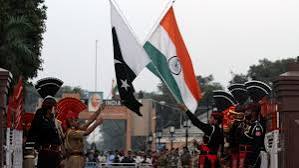A dramatic spike in hostilities has unfolded between India and Pakistan, as both nuclear-armed neighbours exchanged heavy cross-border fire on Wednesday, resulting in the deadliest confrontation between the two countries in over 20 years. The violence followed deadly missile strikes by New Delhi, which targeted areas in Pakistan-administered Kashmir, escalating long-standing tensions rooted in the disputed region.
Authorities in Islamabad reported that 26 Pakistani civilians, including four children, were killed in the Indian strikes and subsequent artillery barrages, while New Delhi confirmed at least eight Indian casualties following retaliatory shelling from the Pakistani side. An additional 29 individuals were reported injured in the Indian town of Poonch, with hospitals overwhelmed by the influx of victims.
The military escalation appears to be a direct response to a brutal attack on April 22 in Pahalgam, a popular tourist destination in Indian-administered Kashmir, where gunmen allegedly linked to the Pakistan-based group Lashkar-e-Taiba—classified by the United Nations as a terrorist organisation—killed 26 civilians, most of whom were Hindu tourists. India swiftly blamed Islamabad for harbouring the perpetrators, setting the stage for a forceful reprisal.
In what Indian military sources described as a “precise and proportionate” action, nine alleged terrorist training camps were targeted across the border using advanced missile technology. The Indian Army claimed the operations were “focused and non-escalatory,” yet the scale of destruction and subsequent Pakistani retaliation indicate otherwise.
Pakistan’s Defence Minister, Khawaja Muhammad Asif, fiercely condemned the strikes, accusing Indian Prime Minister Narendra Modi of leveraging military aggression to boost his domestic image ahead of political milestones. Speaking to Agence France-Presse (AFP), Asif declared, “The retaliation has already started. We won’t take long to settle the score.”
Pakistan’s military claimed to have downed five Indian fighter jets during the crossfire, although Indian officials confirmed that three aircraft crashed, reportedly within Indian territory. The remains of at least one jet were seen by an AFP photographer in Wuyan, a village near Srinagar on the Indian side of Kashmir, as crowds gathered around the wreckage of a fallen fuel tank.
The atmosphere in border communities has turned dire, with civilians bearing the brunt of the violence. In Muzaffarabad, the capital of Pakistan-administered Kashmir, blast damage was visible around a mosque reportedly hit by Indian munitions. Nearby, residents mourned the loss of family members and neighbours as rescue teams searched for survivors amidst shattered homes.
In the Indian town of Poonch, where many were caught off guard, the aftermath of the Pakistani response was equally harrowing. “We woke up as we heard the sound of firing,” said a wounded local, Farooq, speaking from a hospital bed with his head heavily bandaged. “I saw shelling raining down.” AFP reporters on the ground documented multiple shell bursts lighting up the night sky as artillery fire pounded residential areas.
This latest confrontation marks a level of escalation not witnessed since 2019, when India launched airstrikes against what it claimed were militant targets in Balakot following a deadly suicide bombing on its paramilitary forces. While tensions have never fully eased, the current scale of military action and civilian casualties points to a dangerously deteriorating security landscape in South Asia.
With both nations maintaining sizable nuclear arsenals, the international community has expressed growing concern over the potential for wider conflict. However, official statements from New Delhi suggest India is attempting to portray its actions as restrained, while Islamabad insists it is acting in self-defence.
As of now, the region remains on high alert, with diplomatic channels reportedly activated but yielding little sign of immediate de-escalation. Civilians on both sides of the Line of Control continue to live under the shadow of artillery fire, as the world watches anxiously for signs of restraint—or further escalation.
